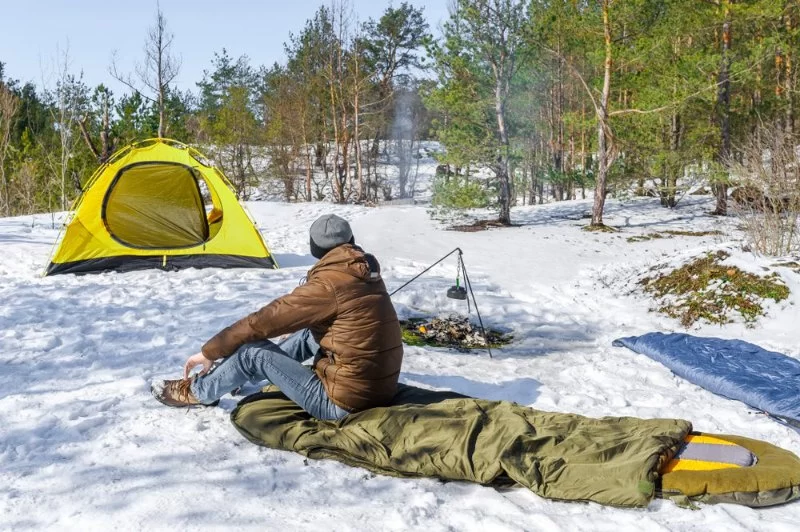- 1. Why a Good Sleeping Pad is Crucial for Winter Camping
- 2. Factors to Consider When Choosing a Sleeping Pad for Winter
- 3. Types of Sleeping Pads for Winter Camping
- 4. Insulation and R-Value Explained
- 5. How to Maintain Your Sleeping Pad for Cold Weather Camping
1. Why a Good Sleeping Pad is Crucial for Winter Camping
When you’re braving the cold during winter camping, the quality of your sleep can make or break your experience. One of the most important factors in ensuring a good night’s sleep in freezing temperatures is the sleeping pad you choose. A good sleeping pad not only provides comfort but also serves as a critical layer of insulation between your body and the cold ground. Without adequate insulation, you can lose body heat rapidly, which can lead to a restless, uncomfortable night or even hypothermia in extreme cases.
Winter camping presents unique challenges, especially in terms of warmth. While you may have a high-quality sleeping bag to keep you cozy, the right sleeping pad is essential to provide that extra layer of protection against the cold ground. Let’s dive into how to choose the right sleeping pad for winter camping to ensure both comfort and warmth.
2. Factors to Consider When Choosing a Sleeping Pad for Winter
Choosing the right sleeping pad for winter camping involves considering a variety of factors to ensure comfort and warmth. Here are some key aspects to think about when selecting a sleeping pad for your cold weather adventures:
- Insulation: In cold conditions, a sleeping pad with adequate insulation is essential. The better the insulation, the more warmth it provides by preventing heat loss to the ground.
- Size and Thickness: A thicker pad provides more cushioning and insulation. Consider your body size and the type of camping you'll be doing. A thicker pad will be more comfortable for side sleepers and will offer better warmth.
- Weight and Packability: In winter, you'll likely be carrying more gear, so a sleeping pad that is lightweight and easy to pack is crucial. While thicker pads are better for warmth, look for ones that balance weight and comfort.
- Durability: Winter camping often involves harsh conditions. A sleeping pad made of durable materials will stand up to rough terrains, snow, and freezing temperatures. Look for options with robust outer layers to avoid punctures or damage.
3. Types of Sleeping Pads for Winter Camping
There are several types of sleeping pads available, each designed to meet different needs during winter camping. Here are the most common types:
- Self-Inflating Pads: These pads are easy to use and provide excellent insulation. They consist of open-cell foam that inflates automatically when you open the valve, offering a comfortable sleeping surface. Self-inflating pads are great for those who want a hassle-free setup but still need good insulation.
- Air Pads: These pads are inflatable and offer the most compact and lightweight option. While they don’t provide as much insulation as self-inflating pads, they can be combined with a foam pad for extra warmth and comfort. Make sure to look for high R-value air pads for winter use.
- Closed-Cell Foam Pads: These pads are made of durable, dense foam and are highly insulating. While not as comfortable as inflatable options, they provide reliable warmth and are virtually indestructible. They are also the lightest and most compact option, but offer less cushioning compared to other types.
4. Insulation and R-Value Explained
When it comes to winter camping, the R-value of a sleeping pad is one of the most important factors to consider. The R-value measures the pad’s ability to resist heat flow; the higher the R-value, the better the insulation. For winter camping, look for a sleeping pad with an R-value of at least 4 or higher. Pads with R-values above 5 are ideal for very cold conditions and extended stays in freezing temperatures.
R-value is particularly important in winter because even the thickest sleeping pads can lose their effectiveness if they don’t have sufficient insulation. It’s also crucial to combine a high R-value pad with a good sleeping bag for optimal warmth during cold weather camping.
5. How to Maintain Your Sleeping Pad for Cold Weather Camping
Proper maintenance of your sleeping pad can extend its lifespan and ensure it continues to perform well during winter camping trips. Here are a few tips on maintaining your sleeping pad:
- Keep it Dry: Moisture can reduce the insulating properties of your sleeping pad, so always ensure it is completely dry before packing it away. In cold conditions, moisture buildup can make your pad less effective.
- Use a Foot Pump or Manual Inflation: To avoid using the car’s battery for inflation, consider a foot pump or manual pump for inflating air pads. This reduces the risk of moisture from your breath getting trapped inside.
- Store Properly: Store your pad in a cool, dry place and avoid rolling it up too tightly to preserve its shape and insulation. For long-term storage, leave the valve open to prevent internal air pressure from damaging the pad.
- Avoid Punctures: While winter camping, avoid placing sharp objects under your pad, and keep it free of sticks, rocks, or other debris that could cause punctures. Carry a patch kit with you just in case.
If you're planning a winter camping trip and need advice on choosing the best sleeping pad for your needs, visit [Pine Cliff Resort]. We offer a range of winter camping gear and expert recommendations to help ensure you stay warm and comfortable in the great outdoors.







